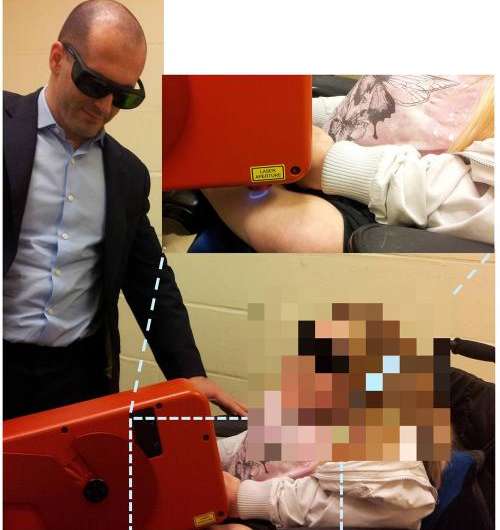First human trials show non-invasive diagnosis of bone diseases possible

New research announced today could lead to the early diagnosis and treatment of chronic, debilitating conditions such as 'brittle bone' and osteoporosis, and help improve the lives of tens of thousands of sufferers in the UK alone. It could enable doctors to identify the bone diseases without having to use invasive diagnostic methods, or exposing patients to radiation associated with the usual X-ray techniques.
This research has, for the first time, enabled detection of a genetic 'brittle bone' disease known as Osteogenesis Imperfecta (OI) by simply scanning a patient's limbs. Until now, bone diseases have been diagnosed through X-rays, history of fractures and other clinical symptoms and, in the case of OI, genetic testing.
The researchers, from UCL (University College London), the Science and Technology Facilities Council (STFC) and the Royal National Orthopaedic Hospital (RNOH) used a technique known as Spatially Offset Raman Spectroscopy (SORS) to test for the condition. The technique involves shining a laser through the skin to analyse the underlying chemistry of the bone, and can reveal differences between healthy and diseased bone. The general SORS concept was developed at the STFC Central Laser Facility, based at the Research Complex at Harwell, Oxfordshire.
To obtain a set of control data, the research team carried out tests on a small bone sample taken from a 26 year old female patient with type IV OI. This is a moderate form of the disease that affects growth and can cause bone deformity and spinal curvature.
Using conventional Raman spectroscopy, the team probed the bone and compared it to a non-diseased bone sample, establishing a notable chemical difference in its make-up.
The patient's body was then scanned extensively and non-invasively, using a laser in a custom-built SORS instrument developed by Cobalt Light Systems. For comparison, a second set of scans were carried out on a healthy female volunteer of a similar age, who does not have the disease.
"Bone is a complex material that has both mineral and protein components," said Dr Kevin Buckley from STFC's Central Laser Facility, one of the team working on this project. "Traditional X-ray methods that are used to study bone can only see the mineral but this technique can see both components"
The OI patient's bone sample was found to be significantly more mineralised than the non-diseased sample, and was therefore structurally brittle.
"The results confirm that SORS can detect abnormalities in the bone composition", added Dr. Buckley. "Osteogenesis Imperfecta is relatively rare, but the hope is that the technology will now allow the early detection of other bone diseases. That would be a step forward because earlier detection would mean earlier treatment and enhanced quality of life"
Professor Allen Goodship from UCL's Institute of Orthopaedics and Musculoskeletal Science led the research. He said, "The SORS technique represents an improvement on X-ray methods as it can extract more information on the precise chemical make-up safely. I can envisage this developing into a routine tool that your local surgery can use when you go for your annual check-up, enabling early detection of conditions, early prescription and monitoring of medication, and will allow doctors to advise patients on lifestyle changes that could slow the progress of the disease further. With regular screening, SORS can monitor the effects directly"
Osteoarthritis and osteoporosis are on the increase in countries with aging populations. In the UK alone there are more than 70,000 hip fractures associated with osteoporosis and a further 70,000 primary hip replacements associated with osteoarthritis annually.
"Presently, the range of clinical tools for early detection of these diseases is limited", said UCL's Dr Jemma Kerns, a researcher and clinical study manager for the project. "In the case of osteoporosis, people at higher risk of a fracture are identified using an association with bone density. However, the successful diagnosis of fracture risk in an individual is currently quite low. The SORS method could improve that rate and pave the way for studies of other bone diseases that have a large societal and economic impact."
More information: "Measurement of abnormal bone composition in vivo using noninvasive Raman spectroscopy." IBMS BoneKEy (2014) 11, Article number: 602 (2014) DOI: 10.1038/bonekey.2014.97



















